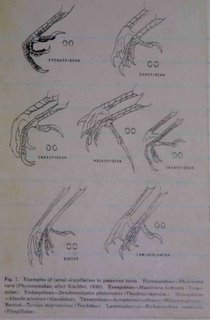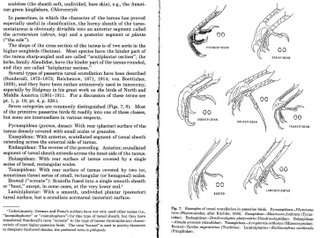
Many posts ago I mentioned the topic the rendering of bird feet. I was working on the feet of the Screaming Piha and thought about opening up a blog discussion purely on feet...pitfalls and triumphs, techniques and schools of thought. Feet are an interesting part of the bird and are often a challenge to represent. First of all lets look at feet...Passerine feet to start, from a scientific perspective. The tarsi and toes of a bird can tell you a lot. Patterns are taxon specific, starting with toe arrangement of course, but even the actual scute morphology, size, arrangement and number are diagnostic. Here is a diagram from my old ornithology notebook with a few scutellation patterns.
The quality isn't great and the text is difficult to read. The scutellation types shown here are:
PYCNASPIDEAN: Phytotomidae, the Plantcutters, a small neotropical group
EXASPIDEAN: Tyrannidae, the Tyrant flycatchers
ENDASPIDEAN: Dendrocolaptidae, the Woodcreepers, a large neotropical group
HOLASPIDEAN: Alaudidae, the Larks, (note the long back claw)
TAXASPIDEAN: Rhinocryptidae, the Tapaculos
BOOTED: Turdidae, the Thrushes (and many others I believe)
LAMNIPLANTAR: Fringillidae, finches (and also many others I believe)
Toe length and claw curvature is another aspect that needs to be paid close attention. Take a look at this page out of Fuertes's Citizen Bird illustrations to see a wide array very nicely rendered foot types.
To be continued.

Today, Tuesday 16 January 2007, I tracked down the figure from VanTyne and Berger's Fundamentals of Ornithology. Here is a much better resolution scan, with the facing page infor for those interested.

No comments:
Post a Comment